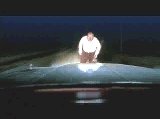| Radiohead was one of the few alternative bands of the early '90s to draw heavily from the grandiose arena-rock that characterized U2's early albums. But the band internalized that epic sweep, turning it inside out to tell tortured, twisted tales of angst and alienation. Vocalist Thom Yorke's pained lyrics were brought to life by the group's three-guitar attack, |
|
Thom Yorke (vocals, guitar), Ed O'Brien (guitar, vocals), Jonny Greenwood (guitar), Colin Greenwood (bass) and Phil Selway (drums) formed Radiohead as students at Oxford University in 1988. Initially called On a Friday, the band began pursuing a musical career in earnest in the early '90s, releasing the Drill EP in 1992. Shortly afterward, the group signed to EMI/Capitol and released the single "Creep," a fusion of R.E.M. and Nirvana highlighted by a noisy burst of feedback prior to the chorus. "Creep" was a moderate hit, and their next two singles, "Anyone Can Play Guitar" and "Pop is Dead," built a small following, even as the British music press ignored the group. Pablo Honey, Radiohead's debut album, was released to mixed reviews in the spring of 1993. As the band launched a European supporting tour, "Creep" became a sudden smash hit in America, earning heavy airplay on modern rock radio and MTV. On the back of the single's success, Radiohead toured the U.S. extensively, opening for Belly and Tears for Fears. All the exposure helped Pablo Honey go gold, and "Creep" was re-released in the U.K. at the end of 1993. This time, the single became a Top Ten hit, and the band spent the following summer touring the world.
 |
Although "Creep" made Radiohead a success, it also led many observers to peg the band as one-hit wonders. Conscious of such thinking, the group entered the studio with producer John Leckie to record their second album, The Bends. Upon its spring 1995 release, The Bends was greeted with overwhelmingly enthusiastic reviews, all of which praised the group's deeper, more mature sound. |
